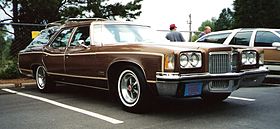Pontiac Grand Safari
| Pontiac Grand Safari | |
|---|---|

1972 Pontiac Grand Safari
|
|
| Overview | |
| Manufacturer | Pontiac (General Motors) |
| Production | 1971–1978 |
| Body and chassis | |
| Class | Full-size car |
| Body style | 4-door station wagon |
| Layout | Front-engine, rear-wheel-drive |
| Related |
Buick Estate Oldsmobile Custom Cruiser |
| Chronology | |
| Predecessor | Pontiac Bonneville Safari (1965) |
| Successor | Pontiac Bonneville Safari (1979) |
| First generation | |
|---|---|

1974 Pontiac Grand Safari
|
|
| Overview | |
| Model years | 1971–1976 |
| Assembly | Pontiac, Michigan, United States |
| Designer | Bill Mitchell |
| Body and chassis | |
| Platform | C-body |
| Related | |
| Powertrain | |
| Engine | 400 cu in (6.6 L) V8 455 cu in (7.5 L) V8 |
| Transmission | 3-speed TH-400 automatic |
| Dimensions | |
| Wheelbase | 127.0 in (3,226 mm) |
| Length | 1971: 230.2 in (5,847 mm) 1972: 228.0 in (5,791 mm) 1973: 228.8 in (5,812 mm) 1974–76: 231.3 in (5,875 mm) |
| Width | 1971–1973: 79.5 in (2,019 mm) 1974–1975: 79.6 in (2,022 mm) 1976: 79.4 in (2,017 mm) |
| Height | 57.8 in (1,468 mm) |
| Curb weight | 5,000–5,300 lb (2,300–2,400 kg) |
| Second generation | |
|---|---|

1977 Pontiac Grand Safari
|
|
| Overview | |
| Model years | 1977–1978 |
| Body and chassis | |
| Platform | B-body |
| Dimensions | |
| Wheelbase | 115.9 in (2,944 mm) |
The Pontiac Grand Safari was Pontiac's top-of-the-line full-size station wagon offered from 1971 to 1978. The Grand Safari used the grille and interior trim of the Bonneville and Grand Ville passenger car series, and most (but not all) examples were trimmed with woodgrain paneling on the sides and tailgate.
The 1971 to 1976 models were the largest Pontiacs ever built. The 1971-76 GM full-size bodies, at 64.3" front shoulder room and 63.4" rear shoulder room set a record for interior width that would not be matched by any car until the full-size GM rear-wheel drive models of the early to mid-1990s.
The Grand Safari wagons, as did other GM full-sized wagons during these years, used a unique rear suspension with multi-leaf springs instead of the coil springs used on other full-sized Pontiacs, and other full-sized GM cars.
The Grand Safari wagons also featured a new 'Clamshell' tailgate design, marketed as the Glide-away Tailgate, where the rear power-operated glass slid up into the roof as the tailgate (manually or with power assist), slid into a recess under the cargo floor. The power tailgate, the first in station wagon history, ultimately supplanted the manual tailgate, which required marked effort to lift from storage. The power system was operated by switches on the instrument panel or a key switch on the rear quarter panel. The Clamshell system, heavy and complex, made it easier to load and unload the extremely long wagons in tight spaces. But it remained unique to GM, and would be subsequently eliminated when GM reduced the length of their wagons by about a foot in 1977, and the overriding concern became increased fuel economy.
The 1971-76 Grand Safaris, shared their 127.0 in (3,226 mm) wheelbase with the Buick and Oldsmobile C-body cars but were designated as B-bodies. At 231.3 in (5,875 mm) in length the 1974-76 Grand Safaris are the longest Pontiacs ever built. And at 5,112 lb (2,319 kg) shipping weight, or about 5,300 lb (2,400 kg) curb weight, the three-seat 1974 Grand Safari wagons are easily the heaviest Pontiacs ever built.
These wagons ran with V8 engines of either 400 or 455 cubic inches.
...
Wikipedia
